This blog is where I reflect on creative processes, creative happenings, creative experiences and creative artefacts.
The Art of Seeing.
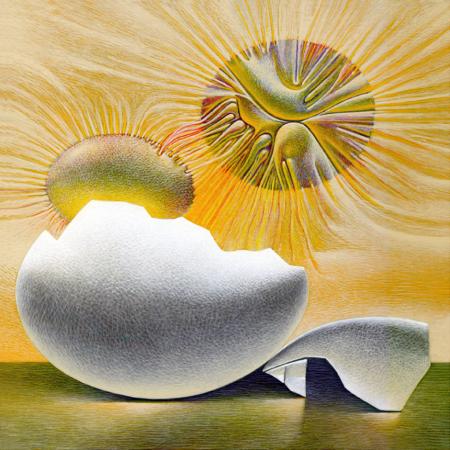 Genesis II by Rudolf Bikkers, 2009
Genesis II by Rudolf Bikkers, 2009
I still remember the day, in my first year OCAD figure drawing class, when I was taught to see.
I was using conté to define the shadow under the breast of the model when my instructor came up behind me with an eraser and showed me how every surface reflected off of each other creating highlights and shadows that we miss when we look instead of see. I was speechless as I watched him use the eraser to uncover all the details that I had failed to see. That breast became real, 3-dimensional, believable and I became humbled.
Yesterday I spent an afternoon in the home of Rudolf Bikkers and I was humbled once again. This is a man who
sees beyond light and shadow.
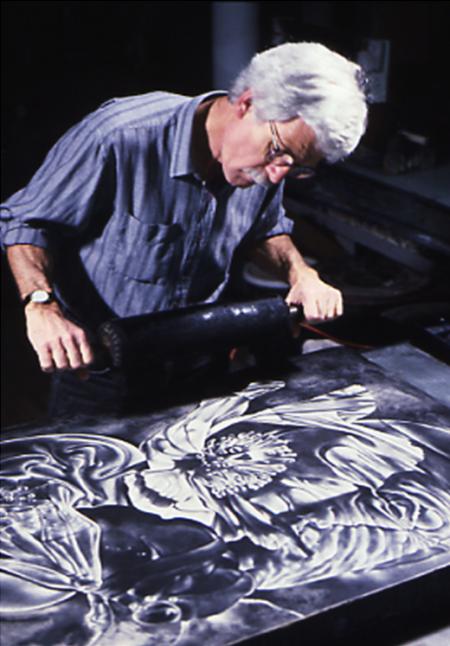 Rudolf Bikkers inking a 44” x 30” litho stone for Man/Insect.
Rudolf Bikkers inking a 44” x 30” litho stone for Man/Insect.
Rudolf Bikkers is a master printmaker who is renowned for his skill as a lithographer. He is also a painter, teacher, publisher and musician.
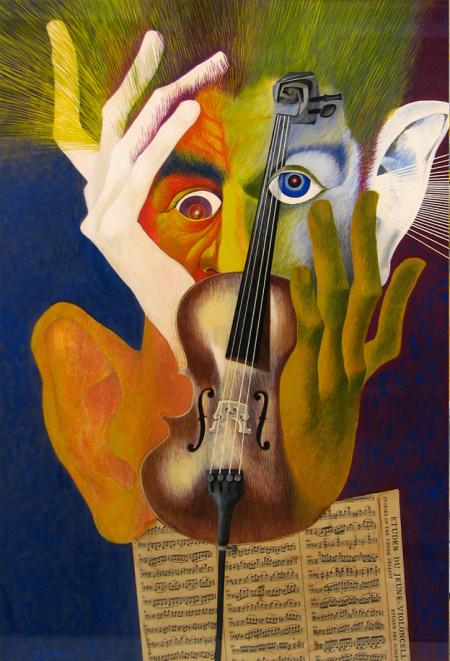 Frustrated Cellist,1969. By Rudolf Bikkers.
Frustrated Cellist,1969. By Rudolf Bikkers.
Every wall in Rudolf's home is filled with paintings and prints done by himself and by accomplished friends and acquaintances he has met throughout his career. Standing in the dining-room I was drawn into Rudolf's work. Each piece is a window into a new world. His mastery of light and shadow makes his work so 3 dimensional that I felt as though I could climb inside. One large painting that hung in the sitting-room appeared to undulate and pulse as my eyes slid around on the sensual forms.
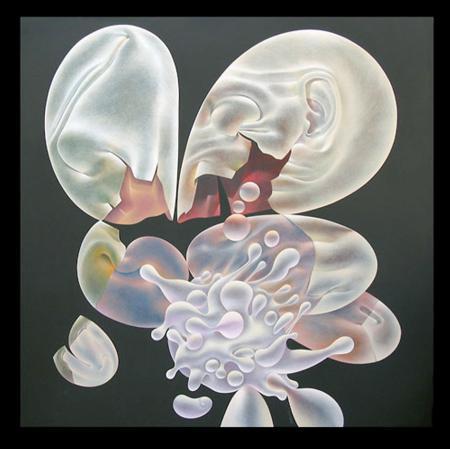 Genesis by Rudolf Bikkers, 1990.
Genesis by Rudolf Bikkers, 1990.
I asked Rudolf what kind of references he used when he drew these organic forms. I was trying to imagine what he might use in a still life to represent these objects. He smiled and said "none". My expression must have asked my next question because he answered before I could speak. "It comes from knowing, from years of observation and drawing", he explained. "Hardly a day goes by that I do not draw." He showed me two illustrations that were done when he was a child and my jaw almost hit the floor.
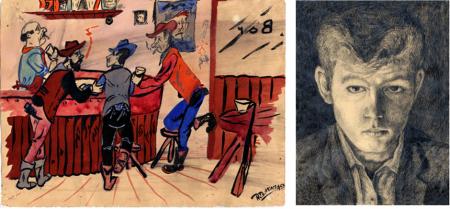 Left: Cartoon at age 10, 1953 Right: Self-portrait at age 14, 1957. By Rudolf Bikkers.
Left: Cartoon at age 10, 1953 Right: Self-portrait at age 14, 1957. By Rudolf Bikkers.
Rudolf was born in the Netherlands and started drawing early in his childhood. At age 9 he had a drawing instructor who would critique his work and helped Rudolf see. Rudolf was also devoted to his music and at age 15 he bought his first Cello with the money he made selling biblical illustrations. He won a scholarship to the Jan van Eyck Akademie in Maastricht, Holland. After graduation he moved to Canada to pursue his career.
When I asked him why he left Holland, a haven for artists and designers, his response was three-tiered. The first reason was to gain independence from his family. The second reason was to avoid the draft. It was at that time mandatory in Holland that everyone serve 2 years in the army. Rudolf did not believe that his hands were meant to hold a gun and moving out of Europe was the only way to avoid this. The third reason was quite interesting to me and spoke volumes of Rudolf's respect for his work, for himself and for the arts. The Dutch government was very generous in its funding of artists and Rudolf was in disagreement with this process. Artists were not independent and their reliance on their allowance only strengthened the notion of "the starving artist." Rudolf believes that it isn't good that artists are seen as poverty stricken. Artists need to rise above this stereotype and not feed into it. This tenacity is what helped Rudolf become an entrepreneur. For example in 1975 he established Editions Canada, a master print studio that published many national and international artists. Recently he approached Epson with an idea to publish a collection of Giclee prints by numerous artists using Epson inks and a high-end Epson printer – Epson agreed.
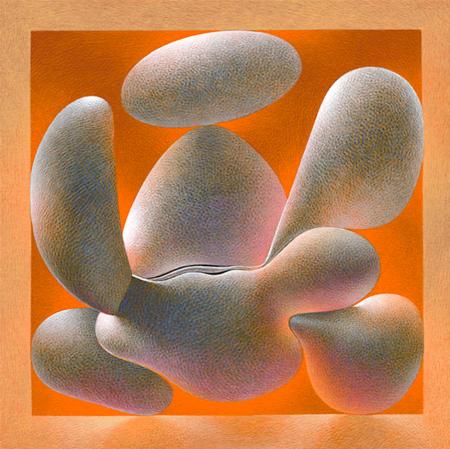 Genesis II, 2009. By Rudolf Bikkers.
Genesis II, 2009. By Rudolf Bikkers.
Rudolf has made a career being an artist and he has a clear definition of what commercial art is and what fine art is. Rudolf is often hired to do portraiture which he does not consider artistic, unless he knows the subject personally. He feels that these are exercises in skill and is not him. In fact he sometimes doesn't even sign his portraits. He believes that his art is autobiographical. He showed me a self-portrait that he did immediately following his diagnosis of diabetes. A disturbing image of a head with an unhinged jaw. Half the head is a skull and the other half is Rudolf. It appears as though the jaw is pulling itself off the head. Rudolf also showed me a painting which he created after having discovering he had skin cancer. He believes he helped remove the cancer from his body through working on a painting in which he depicted "release." It is obvious that commissioned portraits don't fit into this autobiographical journey.
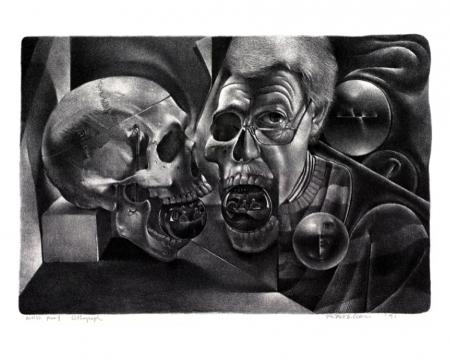 Self Portrait, 1991. By Rudolf Bikkers.
Self Portrait, 1991. By Rudolf Bikkers.
I began noticing that our conversation kept circling back to teaching. Teaching is a very important part of Rudolf's career. He sees his student's spontaneity and naïvety as an integral part of his learning process. He went on to talk about practice and observation and the importace of exploring, living, seeing and learning. He is concerned about his students' desire for instant perfection, instant understanding and their struggle against progressing through practice and skill development. He believes that this desire for immediate results is a result of technology. Technology has made everything instant – everything else is becoming faster so why aren't we? Art is becoming less about experiences, understanding and skill and life is become more and more impersonal. It's not that he is anti-technology it's just that he sees how frustrated it is making his students and how anti-social social media is making us.
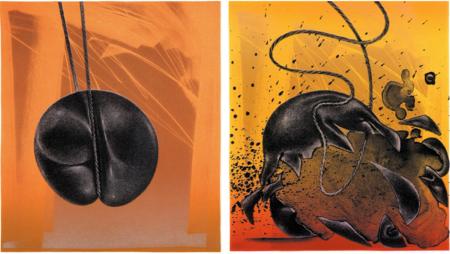 Tension Release by Rudolf Bikkers.
Tension Release by Rudolf Bikkers.
I asked Rudolf if he ever considered using the computer to generate imagery. His response was mixed. He mentioned that he would be interested in seeing what he could do with a tablet but he believes that computer generated work lacks the "human pulse". To understand why Rudolf would say this one needs to know the involved process of lithography:
Every litho stone is ground down by hand using another stone before even beginning to create an image. These stones can be huge and must be perfectly smooth and perfectly level to produce a good print. The image is drawn onto the stone in reverse taking into account the colours that the image requires and the registration of those colours. Every colour is laid down by hand using a huge roller and by moving quickly so that the ink doesn't dry. The registration needs to be exact. The run is limited and the prints are signed and numbered. The stone is then ground down once again for the next project which means that no more prints of this image can be pulled. The beauty of a hand-printed work is that each one is unique.
Rudolf's statement, that a computer generated print lacks the "human pulse", comes from a man who truly knows what it means to create something by hand and heart.
Rudolf's wife Thera joined us with tea, chocolate and biscuits as we finished up our afternoon together. The phone rang and their daughter Anouk was on the line wanting to know if they would like to join her for a walk in the park with her new dog that she rescued from the streets of Taiwan. Not only is Rudolf a printmaker, painter, teacher... but he is also a devoted father and husband. Rudolf has helped Anouk become a printmaker herself and has done a joint project with her. The portfolio that they produced together features hand printed lithographs of animals, a subject very dear to Anouk's heart. Anouk's interpretation is quite realistic. Rudolf took Anouk's images and broke them down into absractions. These images sit side-by-side and the result is both whimsical and humorous.
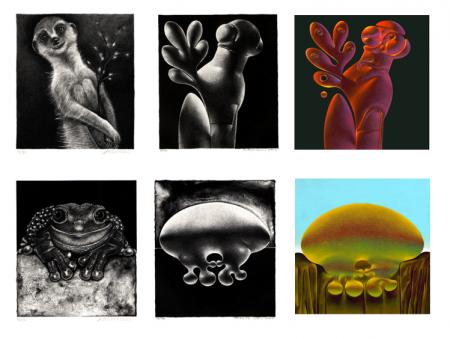 Above: Meercat. Below: Frog. By Anouk and Rudolf Bikkers.
Above: Meercat. Below: Frog. By Anouk and Rudolf Bikkers.
No mere blog could begin to cover the life and work of an individual such as Rudolf Bikkers. I was a bit worried as I exited the Bikkers' home. How would I ever write a blog that would cover everything that needed to be covered? Where does one even start? I walked down the front steps and glanced over my shoulder for a final wave. Out of the corner of my eye I glimpsed a wooden fish hanging in their front window. I had made Rudolf and Thera that fish many years ago. To see that they kept it and that they hung it in the same room as those other, far more impressive, works made me smile. I knew that what I wrote would be fine.
––––––
A biography on Rudolf Bikkers entitled In Search of the Celestial is in the process of being produced. You can see a short promo by clicking on this link http://vimeo.com/1760802
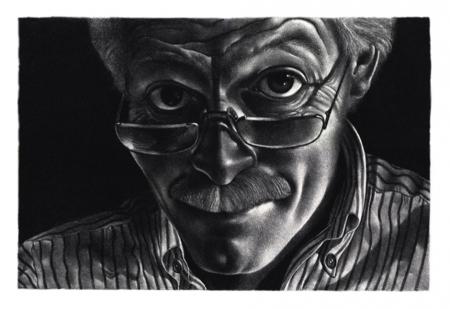 Self Portrait, 1992. By Rudolf Bikkers.
Self Portrait, 1992. By Rudolf Bikkers.
